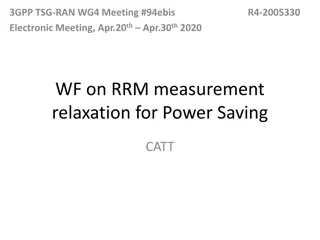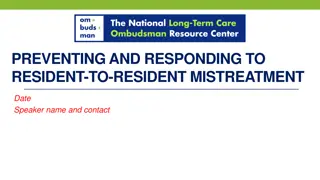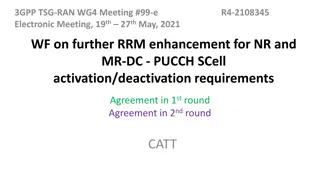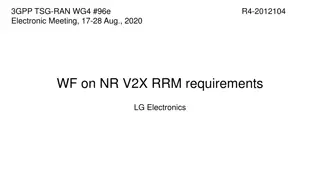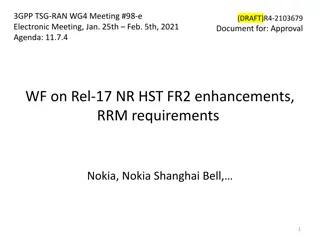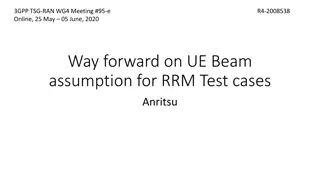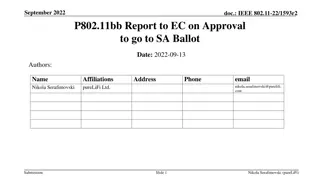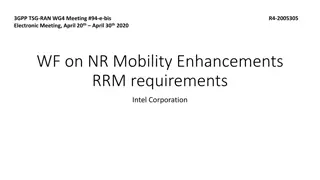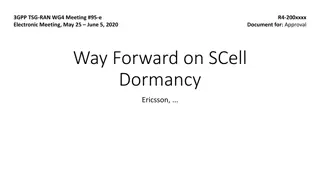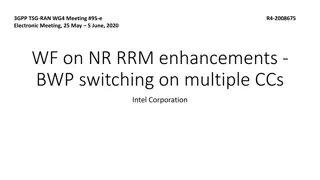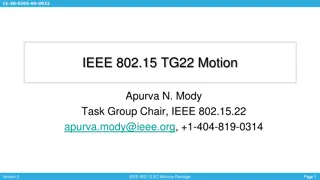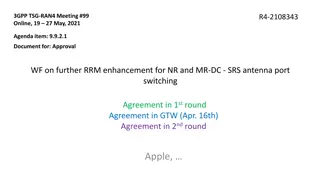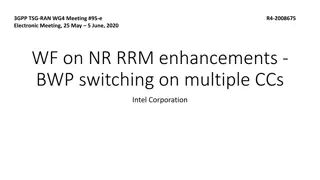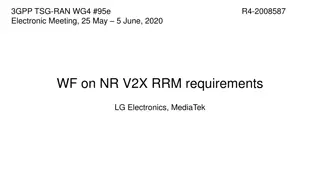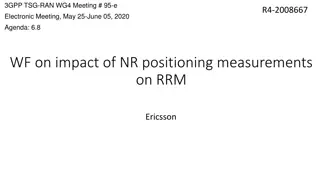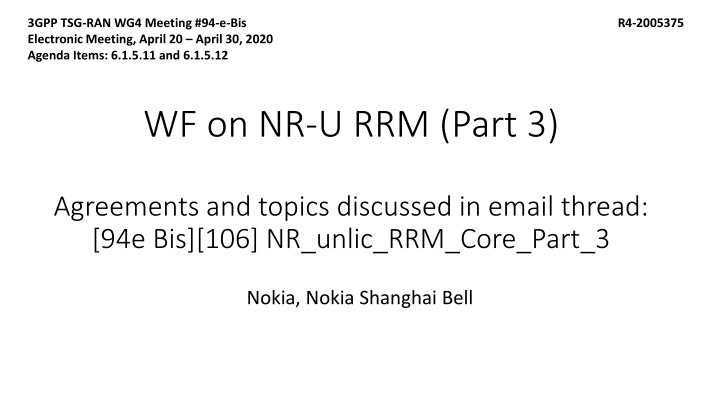
NR-U RRM Agreements and Topics Discussed in 3GPP TSG-RAN-WG4 Meeting
"Explore agreements and topics from the 3GPP TSG-RAN-WG4 Meeting #94-e-Bis on NR-U RRM, covering SFTD measurements, UE behavior, intra and inter-frequency measurements, and more. Dive into critical issues and requirements for improving system performance."
Download Presentation

Please find below an Image/Link to download the presentation.
The content on the website is provided AS IS for your information and personal use only. It may not be sold, licensed, or shared on other websites without obtaining consent from the author. If you encounter any issues during the download, it is possible that the publisher has removed the file from their server.
You are allowed to download the files provided on this website for personal or commercial use, subject to the condition that they are used lawfully. All files are the property of their respective owners.
The content on the website is provided AS IS for your information and personal use only. It may not be sold, licensed, or shared on other websites without obtaining consent from the author.
E N D
Presentation Transcript
3GPP TSG-RAN WG4 Meeting #94-e-Bis Electronic Meeting, April 20 April 30, 2020 Agenda Items: 6.1.5.11 and 6.1.5.12 R4-2005375 WF on NR-U RRM (Part 3) Agreements and topics discussed in email thread: [94e Bis][106] NR_unlic_RRM_Core_Part_3 Nokia, Nokia Shanghai Bell
Agreements from the 1st round Agreements from the 2nd round Agreements from the GoToWebinar Session
Topic #1: SFTD measurements Topic #1: SFTD measurements Issue 1-2: UE behavior when reaching the maximum extension of the SFTD measurement UE behavior upon exceeding Tmeasure_SFTD_LBT_max: UE shall stop the search and stop performing the related measurement.
Topic #2: Remaining issues in intra and inter Topic #2: Remaining issues in intra and inter- - frequency measurements frequency measurements Issue 2-1-1, Issue 2-1-2, Issue 2-1-3 and Issue 2-1-4: Define the following UE capabilities For RLM/BFD/CBD UE is required to monitor at least N1 candidate SSB positions from the set of SSBs that are QCLed with each other within the set of configured resources For intra and inter-frequency measurements UE is required to monitor at least N2 candidate SSB positions from the set of SSBs that are QCLed with each other within SMTC FFS for the case Q is not provided to the UE FFS how to handle IDLE mode capabilities Candidate N1 and N2 values are [1, 2, ] FFS whether N1 = N2 FFS whether to have different capabilities for FBE and LBE modes Send LS to RAN1 to ask for feedback on candidate values N1 and N2 taking into account impact on the overall system performance Further discuss other cases
Topic #2: Remaining issues in intra and inter Topic #2: Remaining issues in intra and inter- - frequency measurements frequency measurements Issue 2-2-2: Additional requirements on consecutively missing SSBs during the measurement period No additional requirement is specified on consecutively missing SSBs
Topic #2: Remaining issues in intra and inter Topic #2: Remaining issues in intra and inter- - frequency measurements frequency measurements Issue 2-3-1: Lmax for the intra-frequency PSS/SSS detection period Following values for intra-frequency: Maximum number of DL LBT failures Rel-15 samples Procedure Parameter name Parameter value Condition 7 5 3 7 5 3 7 5 Max(TDRX,TSMTC) 40 40<Max(TDRX,TSMTC) 320 TDRX>320 Max(TDRX, measCycleSCell) 40 40< Max(TDRX, measCycleSCell) 320 TDRX>320 Max(TDRX,TSMTC, MGRP) 40 40<Max(TDRX,TSMTC, MGRP) 320 PSS/SSS detection, no gaps 5 LPSS/SSS,max PSS/SSS detection for deactivated SCell, no gaps LPSS/SSS,deact,ma 5 x PSS/SSS detection, with gaps 5 LPSS/SSS,gaps,max 3 TDRX>320
Topic #2: Remaining issues in intra and inter Topic #2: Remaining issues in intra and inter- - frequency measurements frequency measurements Issue 2-3-2: Lmax for the inter-frequency PSS/SSS detection period Following values for inter-frequency: Maximum number of DL LBT failures Rel-15 sample s Procedure Parameter name Parameter value Condition 12 Max(TDRX,TSMTC, MGRP) 40 PSS/SSS detection, with gaps 8 LPSS/SSS,gaps,max 8 40<Max(TDRX,TSMTC, MGRP) 320 5 TDRX>320
Topic #2: Remaining issues in intra and inter Topic #2: Remaining issues in intra and inter- - frequency measurements frequency measurements Issue 2-3-3: Requirements when reaching the maximum extension of the detection period Upon exceeding LPSS/SSS,max, the UE is not required to meet the corresponding intra-frequency or inter-frequency PSS/SSS detection requirement.
Topic #3: RSSI and CO measurements in NR Topic #3: RSSI and CO measurements in NR- -U U Issue 3-1-1: Normalization of the RSSI measurement report UE shall not normalize RSSI measurements for reporting purpose Issue 3-1-2: RSSI measurement report mapping RSSI measurement report mapping in NR-U is defined as:
Topic #3: RSSI and CO measurements in NR Topic #3: RSSI and CO measurements in NR- -U U Issue 3-2-3: Need for new measurement gap patterns No new measurement gap pattern to be defined for RSSI Measurements in NR-U. No requirement for RMTC with duration larger than 5ms Issue 3-3-5: Interruption RAN4 to define interruption requirements on SCells that are deactivated when RMTC or measurement cycles are long. LTE LAA requirements in clauses 7.8.2.11 and 7.8.2.12 of TS 36.133 can be used as a starting point.
Issues that need further discussion
The intention of this part of the Way forward is to list the options discussed during RAN4 94e-bis. Companies are encouraged to provide input to the topics in this Section. The issues are detailed in R4-2005390.
Topic #1: SFTD measurements Topic #1: SFTD measurements Issue 1-1: Maximum scaling of inter-RAT SFTD measurements Final candidate options: Option 1: k=4. Option 2: k =3. Note from the moderator: No conclusion in RAN4#94e bis. Most companies compromised to k =4, but one company would agree to compromise on k =3. It is worth noting that the original proposals were k =10 and k=2. The proponents of k=10, already compromised to k=6 and now, k=4. The discussion should be continued in RAN4 #95e.
Topic #2: Remaining issues in intra and inter Topic #2: Remaining issues in intra and inter- - frequency measurements frequency measurements Issue 2-4-1: UE behaviour in case of successively exceeding the maximum number of DL LBT failure during measurements Candidate Options: Option 1 (Original): After N unsuccessful measurement attempts of an already identified cell due to exceeding the max number of unavailable SMTC occasions, UE may restart from the detection stage again. Value of N can be further discussed in RAN4. Option 2 : After N unsuccessful measurement attempts of an already identified cell due to exceeding the max number of unavailable SMTC occasions, UE shall stop the measurement attempts on this SSB, where N is TBD. Option 3: The requirements do not apply after N unsuccessful measurement attempts of an already identified cell due to exceeding the max number of unavailable SMTC occasion. N is TBD.
Topic #2: Remaining issues in intra and inter Topic #2: Remaining issues in intra and inter- - frequency measurements frequency measurements Issue 2-5-1: Assumption of Q in PBCH reading Option 1: Q can be assumed to be always known to the UE Option 2: RAN4 to wait for ASN.1 freeze to decide on whether SSB- PositionQCL-Relationship-r16 can always be assumed known to UE
Topic #2: Remaining issues in intra and inter Topic #2: Remaining issues in intra and inter- - frequency measurements frequency measurements Issue 2-6-1: Scheduling restriction during SS-RSRP and SS-SINR measurement Option 1: When the UE performs intra-frequency measurements in unlicensed spectrum, the following restrictions apply due to SS-RSRP or SS-SINR measurement The UE is not expected to transmit PUCCH/PUSCH/SRS on SSB symbols scheduled to be measured, and on 1 data symbol before each consecutive SSB symbols scheduled to be measured and 1 data symbol after each consecutive SSB symbols scheduled to be measured within SMTC window duration. If the high layer in TS 38.331 [2] signalling of smtc2 is configured, the SMTC periodicity follows smtc2; Otherwise SMTC periodicity follows smtc1. Note from the moderator: companies that could not support option 1 and raised concerns, please bring alternatives to this option on the next meeting, considering the comments captured in the summary.
Topic #2: Remaining issues in intra and inter Topic #2: Remaining issues in intra and inter- - frequency measurements frequency measurements Issue 2-6-2: Scheduling restriction during SS-RSRQ Option 1: When the UE performs intra-frequency measurements in unlicensed spectrum, the following restrictions apply due to SS-RSRQ measurement The UE is not expected to transmit PUCCH/PUSCH/SRS on SSB symbols scheduled to be measured, RSSI measurement symbols, and on 1 data symbol before each consecutive SSB scheduled to be measured/RSSI symbols and 1 data symbol after each consecutive SSB scheduled to be measured/RSSI symbols within SMTC window duration. If the high layer signalling of smtc2 is configured(in TS 38.331 [2]), the SMTC periodicity follows smtc2; Otherwise the SMTC periodicity follows smtc1. When intra-band carrier aggregation in unlicensed spectrum is performed, the scheduling restrictions due to a given serving cell should also apply to all other serving cells in the same band on the symbols that fully or partially overlap with the aforementioned restricted symbols." Note from the moderator: companies that could not support option 1 and raised concerns, please bring alternatives to this option on the next meeting, considering the comments captured in the summary.
Topic #2: Remaining issues in intra and inter Topic #2: Remaining issues in intra and inter- - frequency measurements frequency measurements Issue 2-7-1: UE behaviour in RRC_CONNECTED mode when the serving cell is unavailable for consecutive SSB bursts Candidate options: Option 1: In RRC_CONNECTED mode, UE shall initiate measurements on neighbour cells indicated by the serving cell if it is unable to measure on the serving cell for at least X consecutive number of SSB bursts not available at the UE, where the value of X is TBD. Option 2: Don t introduce new UE behaviors as the problem can be taken care of by existing mechanisms.
Topic #2: Remaining issues in intra and inter Topic #2: Remaining issues in intra and inter- - frequency measurements frequency measurements Issue 2-8-1: Event Triggered reporting delay Modified Option 1: This measurement reporting delay excludes a delay, which is caused by no UL resources being available for UE to send the measurement report on, and all delays due to UL LBT failures until the successfull transmission of the report. Option 2: For event-triggered measurement reporting, the UE measurement reporting delay is extended due to UL LBT failures until the time point of the successful reporting attempt, according to [TBD RAN2 specification]. No extension for UL channel access category 1 Option 1 seemed agreeable, however, one company asked for clarification which was not provided in the discussions. Can companies address the following in the next meeting: on how can we assume or implicitly require that the access is available if we want to ensure a proper operation in unlicensed spectrum? Basically, this translates into the question on how the requirement with option 1 would be tested as reporting in a scenario without UL LBT failures?
Topic #2: Remaining issues in intra and inter Topic #2: Remaining issues in intra and inter- - frequency measurements frequency measurements Issue 2-8-2: Event Triggered periodic and periodic reporting delay Candidate Options: Option 1: For event-triggered periodic and periodic reporting delay, the same definition shall be adopted as in Rel-15. Option 2: For event-triggered and event-triggered periodic measurement reporting, the UE measurement reporting delay is extended due to UL LBT failure. One company asked for clarification of Option 1 which was not provided in the discussions. Can companies address the following in the next meeting: on how can we assume or implicitly require that the access is available if we want to ensure a proper operation in unlicensed spectrum? Basically, this translates into the question on how the requirement with option 1 would be tested as reporting in a scenario without UL LBT failures?
Topic #3: RSSI and CO measurements in NR Topic #3: RSSI and CO measurements in NR- -U U Issue 3-1-3: RSSI measurement reporting criteria Candidate options: Option 1: With Ecat=1, 1 report for RSSI and channel occupancy measurements is capable of minimum 1 RSSI measurement and 1 channel occupancy measurement over a channel [TS 37.213] per carrier frequency with CCA. Option 2: A RSSI/CO report consists of 1 RSSI measurement and 1 CO measurement. RSSI/CO report over multiple sub-bands requires multiple measurement objects.
Topic #3: RSSI and CO measurements in NR Topic #3: RSSI and CO measurements in NR- -U U Issue 3-2-1: Intra-frequency and inter-frequency RSSI definition Candidate options (same as last meeting): Condition 1: Option 1a: RMTC configured SCS is the same as the active BWP in the serving cell. Option 1b: RMTC configured SCS is the same as the SCS of the serving cell SSB, Condition 2: Option 2a: Measurement BW is contained within the active BWP of the serving cell Option 2b: The center frequency of the PRB set configured for RSSI measurement is aligned with the center frequency of an intra-frequency SSB. Moderator: Companies are encouraged to address the concerns captured in the moderator summaries in their contributions for next meetings, and to provide their views on the need for measurement gaps for intra-frequency measurements (Issue 3-2-2).
Topic #3: RSSI and CO measurements in NR Topic #3: RSSI and CO measurements in NR- -U U Issue 3-2-2: Need for measurement gaps for intra-frequency RSSI measurements This discussion is depends on 3-2-1. Please provide your views next meeting. Issue 3-3-1: RSSI measurement bandwidth and assumed bandwidth for RSSI accuracy Option 1: RSSI measurement Bandwdith is the LBT bandwidth Option 2: The RSSI measurement bandwidth is less than the LBT bandwidth.
Topic #3: RSSI and CO measurements in NR Topic #3: RSSI and CO measurements in NR- -U U Issue 3-3-2: RSSI measurement period Option 1: The RSSI and CO measurement periods depend on: max(reportInterval, rmtc-Period) in non-DRX when measurement gaps are not required, max(reportInterval, rmtc-Period, DRX) in DRX when measurement gaps are not required, or max(reportInterval, rmtc-Period, MGRP and gap sharing) in DRX when measurement gaps are required. The CSSF definition and how to account it in the RSSI requirements is to be further discussed Option 2: The RSSI and CO measurement period is scaled with the number of measurement objects / CSSFinter.
Topic #3: RSSI and CO measurements in NR Topic #3: RSSI and CO measurements in NR- -U U Issue 3-3-4: Scheduling Restriction during intra-frequency RSSI/CO measurements Option 1: When the UE performs intra-frequency RSSI/CO measurements in unlicensed spectrum, the following restrictions apply due to RSSI/CO measurements The UE is not expected to transmit PUCCH/PUSCH/SRS on RSSI measurement symbols, and on 1 data symbol before each RSSI symbols and 1 data symbol after each RSSI symbols within RMTC window duration. When intra-band carrier aggregation in unlicensed spectrum is performed, the scheduling restrictions due to a given serving cell should also apply to all other serving cells in the same band on the symbols that fully or partially overlap with the aforementioned restricted symbols. Moderator: there were concerns with this option in asynchronous scenarios. Please address these concerns in the next meeting.
Topic #4: L1 Topic #4: L1- -RSRP RSRP Issue 4-1-1: UE behavior when receiving the MAC CE deactivation command for semi-persistent CSI reporting, in case of UL LBT failure for sending the ACK Candidate options: Option 1: If UE cannot transmit HARQ-ACK on MAC-CE deactivation due to UL CCA failure, UE continues to be in its previous state, i.e., it should measure and report L1-RSRP until it successfully transmits HARQ-ACK Option 2: For semi-persistent CSI reporting with PUCCH, if UE cannot transmit HARQ-ACK on the MAC CE deactivation due to the UL LBT failures, UE continues the L1-RSRP measurements but delay the L1-RSRP reporting. If UE does not receive deactivation command during the delay period, UE restarts to transmit L1-RSRP reporting. FFS how to extend the delay. Option 3: It is preferred to delay the L1-RSRP reporting when the HARQ feedback cannot be transmitted after receiving the MAC CE deactivation command. A time limit shall be defined when the L1-RSRP reporting is delayed. When exceeding the time limits, UE shall abandon the stored measurement results, where the time limit is FFS. The UE shall also abandon the measurement results when the HARQ feedback is retransmitted for the deactivation command
Topic #4: L1 Topic #4: L1- -RSRP RSRP Issue 4-1-2: Semi-persistent L1-RSRP reporting delay Issue 4-1-3: Semi-persistent CSI reporting delay Candidate options: Option 1: Extend the delay, how to extend the delay is FFS Option 2: Semi-persistent L1-RSRP reporting delay in NR-U reuses the Rel-15 reporting delay
Topic #4: L1 Topic #4: L1- -RSRP RSRP Issue 4-2-1: CSI-RS based L1-RSRP Option 1: Set the CSI-RS based L1-RSRP evaluation period for NR-U as follows: Configuration non-DRX DRX cycle 320ms DRX cycle > 320ms Note 1: TL1-RSRP_Measurement_Period_CSI-RS(ms) max(TReport, ceil((M+L1)*P)*TCSI-RS) max(TReport, ceil(1.5*(M+L1)*P)*max(TDRX,TCSI-RS)) ceil((M+L1)*P)*TDRX TCSI-RS is the periodicity of CSI-RS configured for L1-RSRP measurement. TDRX is the DRX cycle length. TReport is configured periodicity for reporting. L1=0 if higher layer parameter timeRestrictionForChannelMeasurement is configured. Otherwise L1 is the number of CSI-RSs not available at the UE during TL1- RSRP_Measurement_Period_CSI-RSwhere L1 L1,max. L1,max=7 for Max(TDRX,TCSI-RS) 40ms where TDRX=0 for non-DRX, L1,max=5 for 40ms < Max(TDRX, TCSI-RS) 320ms, and L1,max=3 for TDRX > 320ms. Note 2: Note 3: Moderator: one company commented that, since CSI-RS is not designed for detection purpose, it is unclear how to determine CSI-RS is available or not. Please, address this issue in the next meeting.


